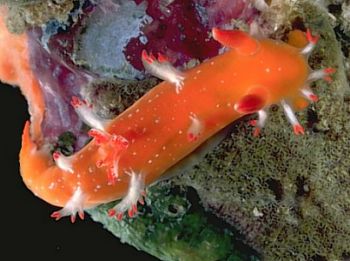
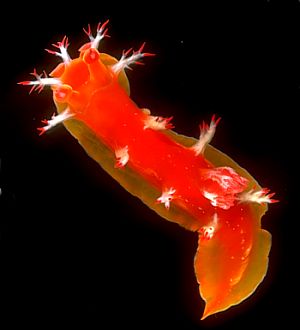
Kaloplocamus acutus
Baba, 1949
Order: NUDIBRANCHIA
Suborder: DORIDINA
Superfamily: ANADORIDOIDEA
Family: Polyceridae
Subfamily: Triophinae
DISTRIBUTION
Previously known only from a few Japanese records, there are published records from Hong Kong and eastern Australia (New South Wales to the northern Great Barrier Reef). I have found it also in New Caledonia.
PHOTO
Solitary Islands, Coffs Harbour region, New South Wales, March 1988. PHOTOS: Bill Rudman.
The head shield or veil is not as pronounced as in Plocamopherus but the six branched papillae are much longer when extended. There are four branched papillae down each side of the body and a slight ridge between them denotes the mantle edge. The body ranges in colour from pale yellow-orange to a deep orange red. The branched papillae have translucent white stalks with some scattered opaque white pigmentation, and the pointed branches are bright orange or orange-red. There are scattered white specks on the body. Unlike Plocamopherus the papillae do not have a terminal sphere. This species, which can grow to 25 mm in length, probably feeds on bryozoans.
Reference:
• Rudman, W.B. & Darvell, B.W. (1990) Opisthobranch molluscs of Hong Kong. Part 1. Goniodorididae, Onchidorididae, Triophidae, Gymnodorididae, Chromodorididae, (Nudibranchia). Asian Marine Biology, 7: 31-79
Rudman, W.B., 2001 (July 5) Kaloplocamus acutus Baba, 1949 . [In] Sea Slug Forum. Australian Museum, Sydney. Available from http://www.seaslugforum.net/find/kaloacut
Related messages
Kaloplocamus acutus from Port Stephens
February 4, 2008
From: Leanne & David Atkinson
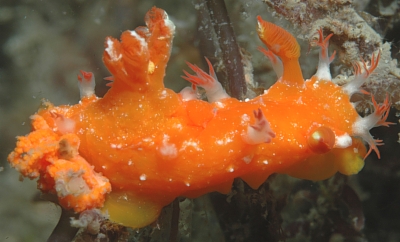
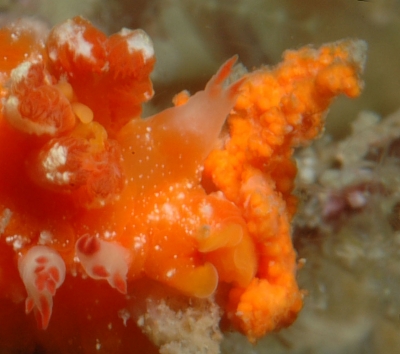
Concerning message #14687:
Dear Bill,
Much to our surprise we found what we think is Kaloplocamus acutus at Fly Point. It seems to have some parasite eggs or damage in the tail region. We haven't seen one here before. You don't have one from the Port Stephens area so thought you might be interested in it.
Locality: Fly Point, Port Stephens - Great Lakes Marine Park, Port Stephens, 7 metres, New South Wales, Australia, Pacific Ocean, 29 January 2008, Sandy bottom with seagrass, algae, bryozoans, ascidians, gorgonians, scattered sponges and soft corals. Length: approximately 20 mm. Photographer: Leanne & David Atkinson.
Best wishes,
Leanne & David Atkinson
atk@hunterlink.net.au
Atkinson, L. & D., 2008 (Feb 4) Kaloplocamus acutus from Port Stephens. [Message in] Sea Slug Forum. Australian Museum, Sydney. Available from http://www.seaslugforum.net/find/21333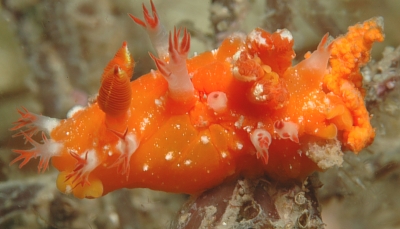
Dear Leanne & David,
Thanks for the record. It is found at times throughout New South Wales but nevr that commonly. Your animal certainly has some damage to its hind quarters but I really can't say what has caused it
Best wishes,
Bill Rudman
Kaloplocamus acutus from Philippines
September 12, 2005
From: Jeff Rosenfeld
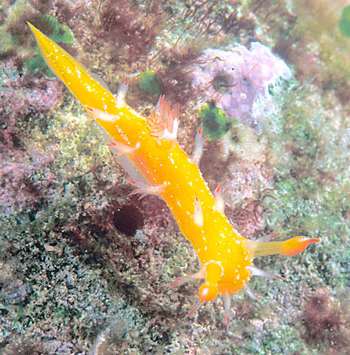
Hi Bill,
Here's a shot of Kaloplocamus acutus taken in Anilao, Luzon Island, Philippines in April, 2004. Apparently, its range is a bit more widespread.
Locality: Anilao, Luzon Island, Philippines. Depth: 40 feet. Length: 12 mm. April, 2004. Photographer: Jeff Rosenfeld
Thanks,
Jeff
http://www.vibrantsea.net
jeff@rosenfeldfamily.net
Rosenfeld, Jeff, 2005 (Sep 12) Kaloplocamus acutus from Philippines. [Message in] Sea Slug Forum. Australian Museum, Sydney. Available from http://www.seaslugforum.net/find/14687Dear Jeff,
This is a great find. The apparent disjunct distribution of this species in the Sino-Japanese region and the south Pacific didn't seem right. It's possible that shipping was involved, but your find in the Philippines helps to strengthen the case for a natural distribution through at least the western Pacific.
Best wishes,
Bill Rudman
Kaloplocamus acutus from South Korea
February 5, 2005
From: Dong Bum Koh
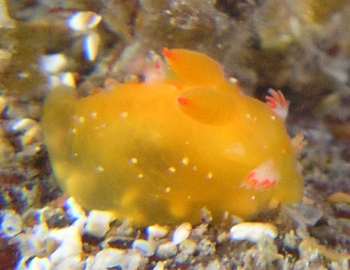
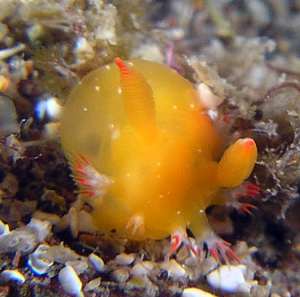
Dear Bill,
This photo of Kaloplocamus acutus was taken at Hwa Soon Beach about 5m depth during night diving. The subject is very tiny and hard to get a good look at with the naked eye. Compare with sandy particle. It was taken by digital camera equipped with magnified lens.
Locality: Jeju Island. Hwa Soon Beach, South Korea. Depth: 5 m.
Length: a few mm. 28 November 2004. Sandy bottom with Rock Wall. Photographer: Youn Byung Ro
Best regards,
From Dong Bum Koh
drkoh@seasee.co.kr
D. B. Koh, 2005 (Feb 5) Kaloplocamus acutus from South Korea. [Message in] Sea Slug Forum. Australian Museum, Sydney. Available from http://www.seaslugforum.net/find/13081Dear Koh,
Thanks for these photos. It does look to be a very small animal. It is nice to get photos from the northern end of this species' range.
Best wishes,
Bill Rudman
Kaloplocamus acutus from Hong Kong
February 5, 2002
From: Bill Rudman & Brian Darvell
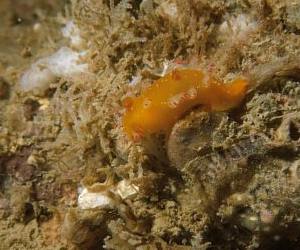
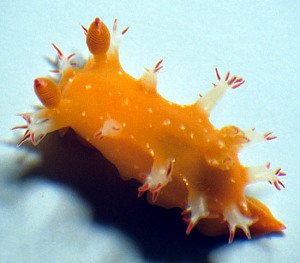
Here is some information and photos on Kaloplocamus acutus from Brian Darvell's Hong Kong collections.
The head shield or veil is not as pronounced as in Plocamopherus but the six branched papillae are much longer when extended. There are four branched papillae down each side of the body and a slight ridge between them denotes the mantle edge. The body ranges in colour from pale yellow-orange to a deep orange red. The branched papillae have translucent white stalks with some scattered opaque white pigmentation, and the pointed branches are bright orange or orange-red. There are scattered white specks on the body. Unlike Plocamopherus the papillae do not have a terminal sphere. This species, which can grow to 25 mm in length, probably feeds on bryozoans.
PHOTO:
UPPER: AM C 146976, 2 specimens, 24 March 1985, Site 8.14, Basalt Is. (SW), 18 m. LOWER: AM C150287, 18 April 1986, Site 4.59, Gau Tau (N), Mirs Bay, 17 m, Hong Kong. Photos: Brian Darvell.
Hong Kong Collection Records:
AM C139167, 2 specimens, 12 April 1983, Site 2.61, Bluff Head, Tolo Channel, 4-7 m. AM C139168, 13 April 1983, Site 4.65, Chek Chau (NE), Mirs Bay, 2-6 m. AM C139169, 2 specimens, 13 April 1983, Site 5.16, Chek Chau (W), Mirs Bay, 2-5 m. AM C 1 39170, 4 specimens, 17 April 1983, Site 5.75, Chu Ma Pai, Tolo Channel, 3-14 m. AM C140171, 24 July 1983, Site 11.87, South Ninepin (SE), 14 m. AM C142186, 31 March 1984, Site 10.99, Kiu Tau (W), Kiu Tsui Chan, Port Shelter, 4 m. AM C142187, 21 April 1984, Site 10. 103, Pak Ma Tsui (Bay), Port Shelter, IO m. AM C 146976, 2 specimens, 24 March 1985, Site 8.14, Basalt Is. (SW), 18 m. AM C150287, 18 April 1986, Site 4.59, Gau Tau (N), Mirs Bay, 17 m. AM C 1 50288, 20 April 1986, Site 2.127, Cock's Head Rock, Mirs Bay, 7 m. AM C153709, 11 July 1987, Site 11. 1 8 1, Duck Rocks (S), Port Shelter, 15 m. Depth range: 2-18 m.
Reference:
• Rudman, W.B. & Darvell, B.W. (1990) Opisthobranch molluscs of Hong Kong. Part 1. Goniodorididae, Onchidorididae, Triophidae, Gymnodorididae, Chromodorididae, (Nudibranchia). Asian Marine Biology, 7: 31-79
Best wishes,
Bill Rudman & Brian Darvell
Kaloplocamus acutus from Hong Kong
July 11, 2001
From: Leslie Chan
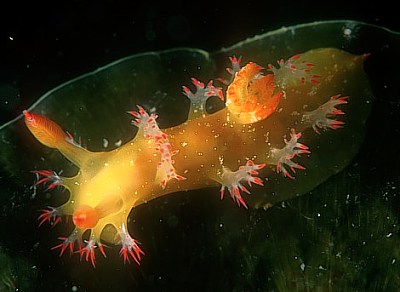
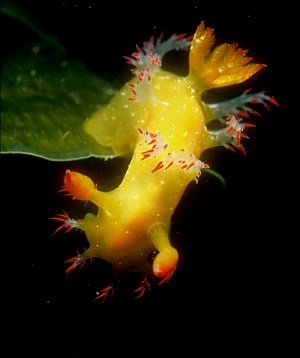
Dear Bill,
Could you identify this nudibranch which I photographed in Hong Kong.
Details: 10m, Tsim Chau, Hong Kong. 3 September 2000.
Thanks
Leslie Chan
leslie@lesmart.com
Chan, L., 2001 (Jul 11) Kaloplocamus acutus from Hong Kong. [Message in] Sea Slug Forum. Australian Museum, Sydney. Available from http://www.seaslugforum.net/find/4759Dear Leslie,
This is Kaloplocamus acutus, which ranges in colour from yellow to almost bright orange red. Previously known only from Japan it has now been found in Hong Kong, and eastern Australia and New Caledonia.
Best wishes,
Bill Rudman
